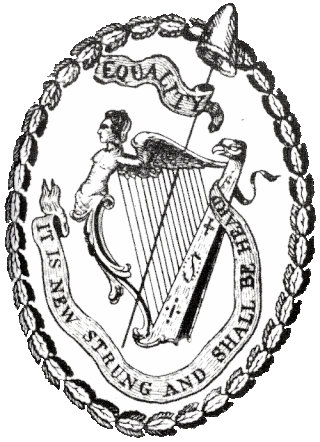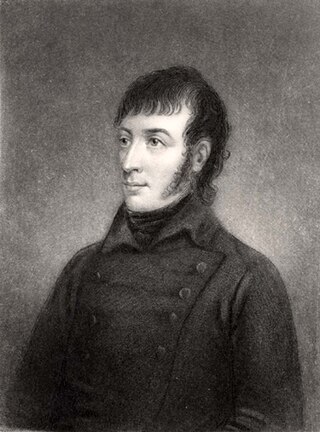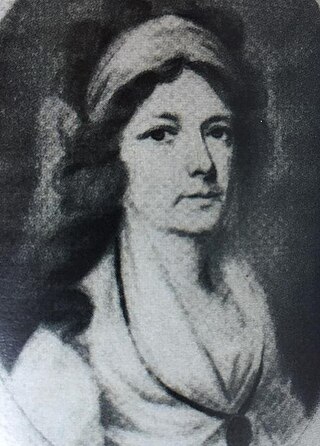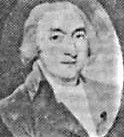
The London Corresponding Society (LCS) was a federation of local reading and debating clubs that in the decade following the French Revolution agitated for the democratic reform of the British Parliament. In contrast to other reform associations of the period, it drew largely upon working men and was itself organised on a formal democratic basis.

The Society of United Irishmen was a sworn association in the Kingdom of Ireland formed in the wake of the French Revolution to secure "an equal representation of all the people" in a national government. Despairing of constitutional reform, in 1798 the United Irishmen instigated a republican insurrection in defiance of British Crown forces and of Irish sectarian division. Their suppression was a prelude to the abolition of the Protestant Ascendancy Parliament in Dublin and to Ireland's incorporation in a United Kingdom with Great Britain. An attempt to revive the movement and renew the insurrection following the Acts of Union was defeated in 1803.

The Irish Rebellion of 1798 was a major uprising against British rule in Ireland. The main organising force was the Society of United Irishmen, a republican revolutionary group influenced by the ideas of the American and French revolutions: originally formed by Presbyterian radicals angry at being shut out of power by the Anglican establishment, they were joined by many from the majority Catholic population.

William Drennan was an Irish physician and writer who moved the formation in Belfast and Dublin of the Society of United Irishmen. He was the author of the Society's original "test" which, in the cause of representative government, committed "Irishmen of every religious persuasion" to a "brotherhood of affection". Drennan had been active in the Irish Volunteer movement and achieved renown with addresses to the public as his "fellow slaves" and to the British Viceroy urging "full and final" Catholic emancipation. After the suppression of the 1798 Rebellion, he sought to advance democratic reform through his continued journalism and through education. With other United Irish veterans, Drennan founded the Belfast [later the Royal Belfast] Academical Institution. As a poet, he is remembered for his eve-of-rebellion When Erin First Rose (1795) with its reference to Ireland as the "Emerald Isle".

Thomas Paliser Russell was founding member, and leading organiser, of the United Irishmen marked by his radical-democratic and millenarian convictions. A member of the movement's northern executive in Belfast, and a key figure in promoting a republican alliance with the agrarian Catholic Defenders, he was arrested in advance of the risings of 1798 and held until 1802. He was executed in 1803, following Robert Emmet's aborted rising in Dublin for which he had tried, but failed, to raise support among United and Defender veterans in the north.

William Sampson was a lawyer and jurist who in his native Ireland, and in later American exile, identified with the cause of democratic reform. In the 1790s, in Belfast and Dublin he associated with United Irishmen, defending them in Crown prosecutions, contributing to their press and, according to government informants, participating on the eve of rebellion in their inner councils. In New York, from 1806 he won renown as a trial lawyer representing the abolitionist Manumission Society and disputing race as a legal disability; challenging the conspiracy charges against organised labor; and, in the name of religious liberty, establishing Catholic auricular confession as privileged. Maintaining that the tradition of common law denied citizens equal access to the law, and was a systematic source of injustice, Sampson pioneered the American codification movement.

Samuel Neilson was an Irish businessman, journalist and politician. He was a founding member of the Society of United Irishmen and the founder of its newspaper, the Northern Star. Along with many other Protestants of Belfast he was radicalised by the French Revolution. In 1797 he was arrested and the Northern Star suppressed by the Irish authorities. In prison during 1798, he took no part in the failed rebellion of that year. Later he went into exile in the United States, where he died of yellow fever.
Events from the year 1794 in Ireland.
Father James Coigly was a Roman Catholic priest in Ireland active in the republican movement against the British Crown and the kingdom's Protestant Ascendancy. He served the Society of United Irishmen as a mediator in the sectarian Armagh Disturbances and as an envoy both to the government of the French Republic and to radical circles in England with whom he sought to coordinate an insurrection. In June 1798 he was executed in England for treason having been detained as he was about to embark on a return mission to Paris.

Charles Hamilton Teeling (1778–1848) was an Irish political activist, journalist, writer, and publisher from Lisburn, County Antrim, Ulster. He was the second son of Luke Teeling a successful Catholic linen merchant who in the cause of complete Catholic Emancipation had been a delegate to the Convention, or "Back Lane Parliament", that had been called by the Catholic Committee in Dublin in December 1792. In 1798, the Teeling mill was to be destroyed by Orangemen.
The Philadelphia Aurora was published six days a week in Philadelphia from 1794 to 1824. The paper was founded by Benjamin Franklin Bache, and was continued as a tri-weekly, after his death from yellow fever in September 1798, as a leading organ of radical republicanism by the Irish-American journalist William Duane.
Robert Simms was an Irish radical, and a founding member in Belfast of the Society of United Irishmen.

The Shan Van Vocht, was the name of a song, dating to the period of the Irish rebellion of 1798 that, once printed, gained notoriety in nineteenth century Ireland as a seditious text. In the 1890s it was adopted as the title of a popular historical novel and of a nationalist magazine, both of which, in the face of the growing sectarian division over Irish Home rule, sought to vindicate the republican legacy of the United Irishmen.

The Catholic Committee was a county association in late 18th-century Ireland that campaigned to relieve Catholics of their civil and political disabilities under the kingdom's Protestant Ascendancy. After their organisation of a national Catholic Convention helped secure repeal of most of the remaining Penal Laws in 1793, the Committee dissolved. Members briefly reconvened the following year when a new British Viceroy, William Fitzwilliam, raised hopes of further reform, including lifting the sacramental bar to Catholics entering the Irish Parliament. When these were dashed by his early recall to London, many who had been mobilized by the Committee and by the Convention, defied their bishops, and joined the United Irishmen as they organised for a republican insurrection.
Henry Haslett was in 1791 a founding member in Belfast of the democratic-revolutionary Society of the United Irishmen, and one of the twelve original proprietors of its Painite newspaper, the Northern Star. He had been representative of a group of merchants in the city who had chafed at the Navigation Acts and other measures enacted under the British Crown that restricted Irish trade and industry. He was released from fourteen-months detention just before the Irish Rebellion of 1798 in which he played no role. After the 1800 Acts of Union incorporating Ireland in a United Kingdom with Great Britain, he was again active in the commercial life of Belfast promoting its growth as a port.

Waddell Cunningham was wealthy merchant and civic leader in late eighteenth-century Belfast, Ireland, who, both in his business ventures and political interventions, was opposed by the nascent democratic spirit of his time. He cut a liberal figure as a patron of the Belfast Charitable Society and its Poor House; as a commander of the Volunteer patriot militia; and as a subscriber to the costs of erecting Belfast's first Catholic chapel. But from within his own majority Presbyterian community this reputation was challenged. In retaliation for his land speculation and evictions, in 1771 his house in Belfast was attacked and destroyed by tenant "Steelboys" from his home region north of the town; in 1786 public protest, organised from within a Presbyterian church to which he had also subscribed, forced him to abandon plans to commission ships in the port for the Atlantic slave trade; and in 1792, following Bastille Day celebrations of the French Revolution, his attempt to water down a town resolution in favour of full and immediate Catholic emancipation was defeated by his Volunteer comrades styling themselves the United Irishmen. As preparations were laid for the 1798 Rebellion, Cunningham was prominent among the town's loyalists in volunteering his services to the local yeomanry.

Martha "Matty" McTier was an advocate for women's health and education, and a supporter of democratic reform, whose correspondence with her brother William Drennan and other leading United Irishmen documents the political radicalism and tumult of late eighteenth-century Ireland.
Jane "Jenny" Greg in the 1790s was an Irish republican agitator with connections to radical political circles in England. Although the extent of her activities are unclear, in suppressing the Society of United Irishmen the British commander, General Lake, described Greg as "the most violent creature possible" and as someone who had caused "very great [political] mischief" in her native Belfast.

Thomas Ledlie Birch (1754–1828) was a Presbyterian minister and radical democrat in the Kingdom of Ireland. Forced into American exile following the suppression of the 1798 rebellion, he wrote A Letter from An Irish Emigrant (1799).

Robert Tennent (1765–1837) was an Irish physician, merchant and philanthropist in Belfast. Representative of a politically radical Presbyterian current in Ireland, in the years following the Acts of Union he was renowned for his confrontations with the local Tory establishment. Among the numerous civic initiatives with which he was associated, the most lasting proved to be Royal Belfast Academical Institution and what is today the Royal Victoria Hospital, Belfast.














